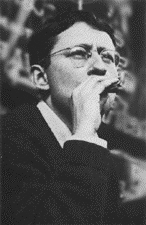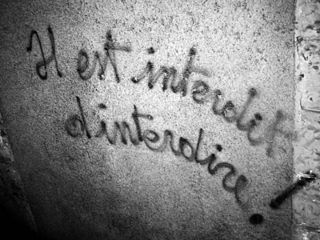
The Situationist International (SI) was an international organization of social revolutionaries made up of avant-garde artists, intellectuals, and political theorists. It was prominent in Europe from its formation in 1957 to its dissolution in 1972. The intellectual foundations of the Situationist International were derived primarily from libertarian Marxism and the avant-garde art movements of the early 20th century, particularly Dada and Surrealism. Overall, situationist theory represented an attempt to synthesize this diverse field of theoretical disciplines into a modern and comprehensive critique of mid-20th century advanced capitalism.

Guy-Ernest Debord was a French Marxist theorist, philosopher, filmmaker, critic of work, member of the Letterist International, founder of a Letterist faction, and founding member of the Situationist International. He was also briefly a member of Socialisme ou Barbarie.

Psychogeography is the exploration of urban environments that emphasizes interpersonal connections to places and arbitrary routes. It was developed by members of the Letterist International and Situationist International, which were revolutionary groups influenced by Marxist and anarchist theory as well as the attitudes and methods of Dadaists and Surrealists. In 1955, Guy Debord defined psychogeography as "the study of the precise laws and specific effects of the geographical environment, consciously organized or not, on the emotions and behavior of individuals." One of the key tactics for exploring psychogeography is the loosely defined urban walking practice known as the dérive. As a practice and theory, psychogeography has influenced a broad set of cultural actors, including artists, activists and academics.

Asger Oluf Jorn was a Danish painter, sculptor, ceramic artist, and author. He was a founding member of the avant-garde movement COBRA and the Situationist International. He was born in Vejrum, in the northwest corner of Jutland, Denmark, and baptized Asger Oluf Jørgensen.

NSCAD University is a public art university in Halifax, Nova Scotia, Canada. The university is a co-educational institution that offers bachelor's and master's degrees. The university also provides continuing education services through its School of Extended Studies.

Anti-art is a loosely used term applied to an array of concepts and attitudes that reject prior definitions of art and question art in general. Somewhat paradoxically, anti-art tends to conduct this questioning and rejection from the vantage point of art. The term is associated with the Dada movement and is generally accepted as attributable to Marcel Duchamp pre-World War I around 1914, when he began to use found objects as art. It was used to describe revolutionary forms of art. The term was used later by the Conceptual artists of the 1960s to describe the work of those who claimed to have retired altogether from the practice of art, from the production of works which could be sold.
Art intervention is an interaction with a previously existing artwork, audience, venue/space or situation. It is in the category of conceptual art and is commonly a form of performance art. It is associated with Letterist International, Situationist International, Viennese Actionists, the Dada movement and Neo-Dadaists. More latterly, intervention art has delivered Guerrilla art, street art plus the Stuckists have made extensive use of it to affect perceptions of artworks they oppose and as a protest against existing interventions.
Michael Fernandes is a Canadian experimental artist and art educator based in Halifax, Nova Scotia. His work uses familiar, even banal materials to ask the viewer to confront the boundary between daily life and art.

The spectacle is a central notion in the Situationist theory, developed by Guy Debord in his 1967 book The Society of the Spectacle. In the general sense, the spectacle refers to "the autocratic reign of the market economy which had acceded to an irresponsible sovereignty, and the totality of new techniques of government which accompanied this reign." It also exists in a more limited sense, where spectacle means the mass media, which are "its most glaring superficial manifestation."
NSCAD conceptual art refers to a period beginning in 1969 when Nova Scotia College of Art and Design (NSCAD), a post-secondary art school in Halifax, Nova Scotia, Canada became an important art centre with an international reputation.
Situation is a concept developed by French philosopher Jean-Paul Sartre. It refers to "how ritualized action might be avoided or at least confronted consciously as contrary to the subject's freedom of nihilation". It was first expressed in his 1943 work Being and Nothingness, where he wrote that:
[T]here is freedom only in a situation, and there is a situation only through freedom [...] There can be a free for-itself only as engaged in a resisting world. Outside of this engagement the notions of freedom, of determination, of necessity lose all meaning.

Brad Buckley is an Australian artist, activist, urbanist and is a Professorial Fellow at Victorian College of the Arts, Faculty of Fine Arts and Music, the University of Melbourne. He is also a foundation research fellow at the Centre of Visual Art (CoVA) at the University of Melbourne. Buckley was previously, Professor of Contemporary Art and Culture at Sydney College of the Arts, University of Sydney. He has exhibited widely, with exhibitions across Australia, and globally in the United States, Germany, Canada, Poland, Japan, New Zealand, Israel and Norway. He has also written widely on contemporary art, art schools, curating and the neo-liberal influence on society. Buckley's writings have been published by Pluto Press Australia, NSCAD Press and Wiley-Blackwell.
Ursula Johnson is a multidisciplinary Mi’kmaq artist based in Halifax, Nova Scotia, Canada. Her work combines the Mi’kmaq tradition of basket weaving with sculpture, installation, and performance art. In all its manifestations her work operates as didactic intervention, seeking to both confront and educate her viewers about issues of identity, colonial history, tradition, and cultural practice. In 2017, she won the Sobey Art Award.
Marusya Bociurkiw is a Canadian born, Ukrainian film-maker, writer, scholar, and activist. She has published six books, including a novel, poetry collection, short story collection, and a memoir. Her narrative and critical writing have been published in a variety of journals and collections. Bociurkiw has also directed and co-directed ten films and videos which have been screened at film festivals on several continents. Her work appears in the collections of the National Gallery of Canada, the National Archives of Canada, and many university libraries. She founded or co-founded the media organizations Emma Productions, Winds of Change Productions, and The Studio for Media Activism & Critical Thought. She currently lives in Toronto, Ontario, Canada where she is an associate professor in the RTA School of Media Studies, Toronto Metropolitan University. She teaches courses on social justice media, activist media production, and gender/race/queer theories of time-based and digital media. She is also Director of The Studio for Media Activism & Critical Thought at Toronto Metropolitan University.
Carole Condé D.F.A. is a Canadian artist whose practice responds to critical contemporary cultural, social, and political issues through the use of collaboration and dialogue. Condé and long-time collaborator and partner Karl Beveridge challenge concepts of ideology, power, and control. In their career, which spans over thirty years, Condé and Beveridge have had over fifty solo exhibitions at major museums and art spaces across four continents, including: the Institute of Contemporary Arts in London, UK; Museum Folkswang in Germany; the George Meany Centre in Washington; Dazibao Gallery in Montréal; Centro Cultural Recoleta in Buenos Aires; the Art Gallery of Alberta; and the Australian Centre for Photography in Sydney.
Karl Beveridge is a Canadian artist. His practice responds to critical contemporary cultural, social, and political issues through the use of collaboration and dialogue. Beveridge and long-time collaborator and partner Carole Condé challenge concepts of ideology, power, and control.
Lucy Pullen is a Canadian artist based in New York. She is best known for crossover projects, sculpture and drawing.
Charlotte Townsend-Gault is an art historian, professor emeritus, author, and curator. Townsend-Gault’s research, teaching and scholarship concerns contemporary visual and material Native American and First Nations cultures, particularly those of the Pacific Northwest.
The NSCAD Lithography Workshop was a program active at NSCAD University from 1969 to 1976 that gave practicing artists the opportunity to visit the school and produce limited edition prints in collaboration with a Master printer. The workshop allowed NSCAD students to witness professional artists develop their ideas and create work through the medium of printmaking. The Lithography Workshop succeeded in elevating the status of the school, both in terms of innovation and technical capacity.
Ian Andrew Hunter was a Northern Irish artist, art curator and cultural advocate who worked in New Zealand and England.







